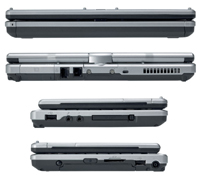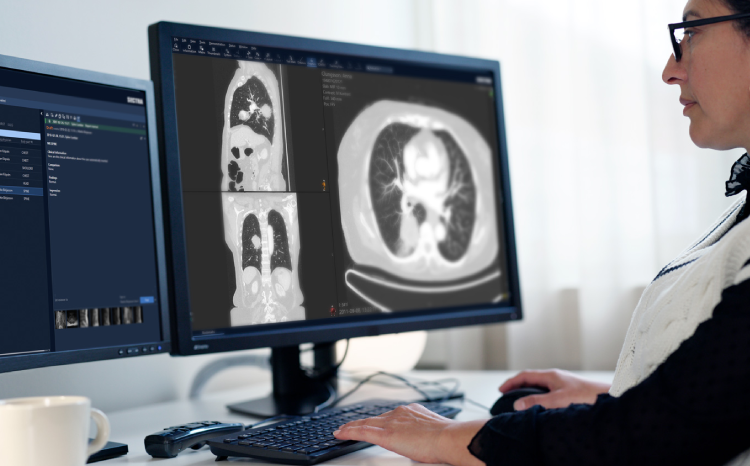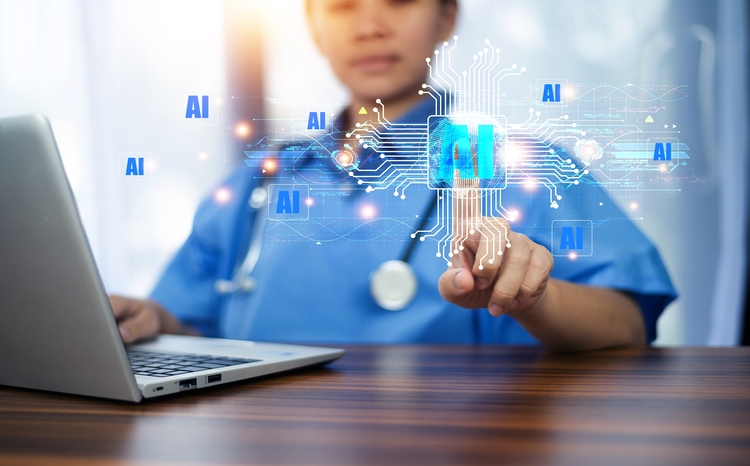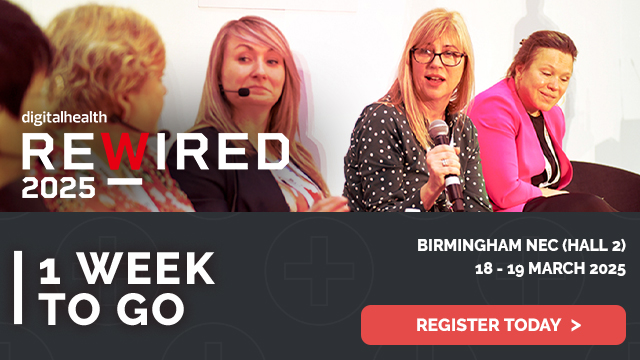Tablet tests
- 29 June 2006
 Super-light tablet PCs might look impressive, but can new technology translate into better care for patients? E-Health Insider asked NHS staff to test Fujitsu-Siemens’ Lifebook P1510 (right), a tablet PC that converts into a laptop, and try to integrate it into their daily routines.
Super-light tablet PCs might look impressive, but can new technology translate into better care for patients? E-Health Insider asked NHS staff to test Fujitsu-Siemens’ Lifebook P1510 (right), a tablet PC that converts into a laptop, and try to integrate it into their daily routines.
Dr Keith Freeman, a consultant dermatologist at the Galleries Health Centre in Washington, Tyne & Wear, Dr Phil Koczan, a GP in Chingford, north-east London, and Sue Wilson, head of electronic patient records at Sandwell & West Birmingham Hospitals NHS Trust, took the laptops for a two-month test drive. Here are their thoughts.
Dr Keith Freeman
Consultant dermatologist, Galleries Health Centre, Washington, Tyne & Wear
The fact that the P1510 is less than half the weight and size of many laptops, but has comparable functionality, will obviously make it attractive to those of us in the medical field that need to work in several locations.
The device is, however, more that just a miniaturised laptop. When opened up, it is a simple manoeuvre to rotate the screen horizontally through 180 degrees and then fold it down, leaving you with a tablet PC, which is much more user-friendly than its larger cousins.
In tablet mode, features include a virtual keyboard which functions well using the stylus, which docks in the side of the Lifebook. The stylus can also be used to write notes on the touch-sensitive screen and, of course, to operate all other features.
I was impressed by the way in which Microsoft’s software recognised my handwritten notes, given that my handwriting is no better than most doctors! This feature is particularly useful when scribbling notes during meetings with colleagues, when visiting patients, or in conferences.
While portability is the major advantage offered by this powerful device, there are a number of other features that are attractive with respect to use in the healthcare arena. Given the confidential nature of some information that is likely to be stored on the Lifebook, security is an obvious concern, particularly as it is likely to be very attractive to potential thieves.
But a major plus point is that the Lifebook can be configured such that it can only be switched on by the registered user swiping a thumb or finger over a pad.
|
"I challenged several people to gain access — all failed. I got in at first attempt" — Dr Keith Freeman, consultant dermatologist, Galleries Health Centre, Washington
|
The pad will not allow access unless it recognises the fingerprint and electrical resistivity of the user’s digit. I am assured that this means that it would not allow access to someone using a digit that had been cut off, but I decided that this was one feature that I had no intention of testing…
I did however challenge several people to gain access — all failed. I got in at first attempt, once I had mastered the speed and pressure required, practice for which took only a few minutes.
There is a well-designed docking station – helpful if one is working at a desk for prolonged periods, providing convenient recharging of the battery and ergonomic positioning. There are two batteries; the one with extended life increases the size and weight of the unit, but it remains eminently portable. The version that I tested did get rather hot with prolonged use, but I understand that this problem is being addressed.
For one who is used to working with a full-sized QWERTY keyboard, I did have some difficulty adjusting to the much smaller one on the Lifebook, but after a few days I was no longer miskeying or hitting more than one key at a time. I certainly found it easier to use than the keyboards present on many other handheld devices.
The version that I tested came with one of the latest voice-recognition systems. It has been some time since I used voice-recognition and the developments have been considerable. Training the software was a painless process and there is considerable scope to use this for dictating structured clinical letters etc, reducing the need for secretarial support.
The combination of this software and the Lifebook offers a great way to document clinics performed by consultants away from their base. Current government policy to move hospital services into the community will require good IT support and I anticipate that the Lifebook could be a key part of this.
Unfortunately neither the primary care trust nor the acute trust where I work would allow me to connect the device to their networks and I was therefore unable to test one of the advantages that the Lifebook offers healthcare workers – access to information and e-mail whilst away from base. Once such local obstacles are overcome, I feel that the Lifebook would prove very attractive to a large range of NHS users.
 If there were sufficient demand, some form of visible NHS branding built into the computer would be worthy of consideration, to deter theft of what is a very tempting piece of kit.
If there were sufficient demand, some form of visible NHS branding built into the computer would be worthy of consideration, to deter theft of what is a very tempting piece of kit.
Dr Phil Koczan
GP, Chingford, north-east London
The device is small compared to normal laptops, which are normally have a display around 14". This makes the device very light and portable. The screen is touch-sensitive and does not need a special pen. A stylus is supplied, but it is possible to use the device using a finger.
The keyboard is small in proportion to a full size laptop or desktop machine; however it is still very usable. The unit has a docking station allowing a full size keyboard, mouse and screen to be added making the system equivalent to a desktop PC, but can be quickly converted to a mobile device.
|
Fujitsu-Siemens Lifebook P1510: Product Sheet 34.5mm x 232mm x 167mm
|
The main benefit of this system comes in its mobility. The touch screen and recently enhanced Windows XP tablet PC software mean that it is possible to run most software without resorting to the keyboard.
There is handwriting recognition software which works with a high degree of accuracy and also voice recognition software built in. These systems allowing data capture without needing to sit at a desk and would be ideal for home visits.
Currently there is limited software for accessing medical records away from the surgery, but systems are currently being developed that should allow access to medical records from the patient’s home. This device is well suited to take advantage of this facility and will be valuable to both GPs and community staff.
The supplied battery only lasts for two hours, which is not sufficient to do a significant amount of work away from mains power. However a larger battery is available with a life of at least four hours. Using the larger battery with the smaller one as a spare makes the possibility of getting a full day’s work out of the device a reality.
The touch-sensitive screen adds a lot of options for using the device as a truly mobile computer for use away from a desk in the community and is more useable than the PDA devices. The software available for managing clinical records has not been fully optimised for the Tablet PC and usability will improve when remote access to records from the patients home becomes a common reality.
Sue Wilson
Head of electronic patient records at Sandwell & West Birmingham Hospitals NHS Trust
The Fujitsu-Siemens Lifebook P1510 would be a useful device to have in an organisation’s portfolio, to offer users a choice and ensure devices are appropriate for the purpose for which they are to be used. It performs well in terms of design and functionality, but does not lend itself to a particular function or environment in an acute care setting.
It may be useful for a specific user group, such as pharmacists or bed managers, who require wireless access to specific information at a number of locations. It could also be used for a single function/role within a specific location, such as ICNARC recording in ICU or clinical dependency scoring in ward areas. It may also be very useful in a community care setting.
It may be useful for a specific user group, such as pharmacists or bed managers, who require wireless access to specific information at a number of locations. It could also be used for a single function/role within a specific location, such as ICNARC recording in ICU or clinical dependency scoring in ward areas. It may also be very useful in a community care setting.
|
"It performs well in terms of design and functionality, but does not lend itself to a particular function or environment in an acute care setting" — Sue Wilson, head of electronic patient records, Sandwell & West Birmingham Hospitals NHS Trust
|
District Nurses had expressed the need for a very light-weight notebook to carry with them as they visited patients in their homes and the Lifebook could well support their needs. Others felt it supported office work such as email, use of MS office and Internet/Intranet access.
One consultant, who used it in ICU and theatres, suggested that he would even like to buy one, as would other colleagues he had shown the Lifebook to. Another consultant, interestingly enough, was very pleased to trial the device as it demonstrated to him that he would prefer a lighter wireless full-size laptop for theatre use, and perhaps his iPAQ for patient results at the bedside in ICU.
For multi-user use the device is only as accessible as the place the last user left it. It requires discipline from users to always return the machine to base!
A small device, such as the Lifebook, could be used for more occasional and ad hoc use than a trolley PC. It would be appropriate for one-to-one interaction with patients by nurses on wards, where a lighter, smaller, more portable device would be easier to carry and rest in the patient’s bed space.
A couple of users would have preferred the Lifebook to be smaller and had some difficulties with the keyboard, but otherwise the size was generally okay. Most users found the weight good to heavy, though this included the slightly larger battery. One user felt that with the standard battery it would be very light, but the life of the battery may be too short for an acute care setting.
The system did crash a few times on the wards, which could have been due to local issues e.g. loss of wireless connection, or due to the fact this was a prototype. Only one user found the device difficult to use. It was also noted that there appeared to be some mapping issues on the keyboard e.g. @ was mapped to “.
The Lifebook worked well accessing both PAS systems, viewing Radiology and Pathology results and the electronic ordering of tests. PACS images were very clear, but understandably too small to be clinically safe to aid diagnosis. Handwriting recognition was attempted with the local iSoft iCM (Clinical Manager) for order requesting, but this failed, either because it required configuration or iCM does not interface with handwriting technologies.
Links
Fujitsu-Siemens
Lifebook P1510 product sheet [PDF]





